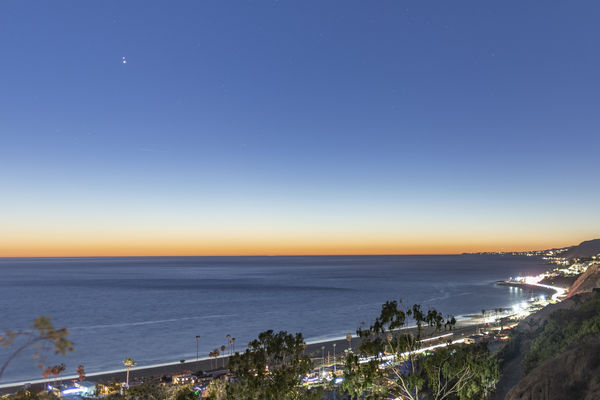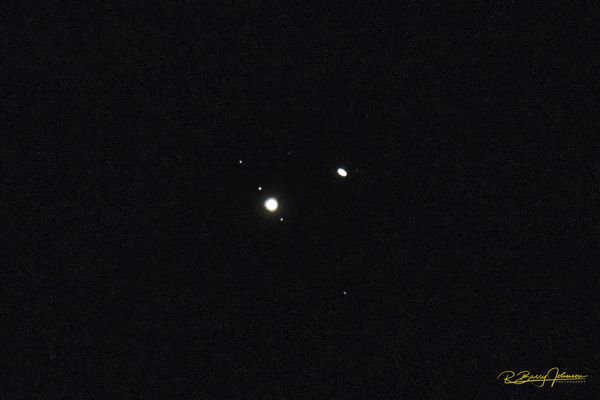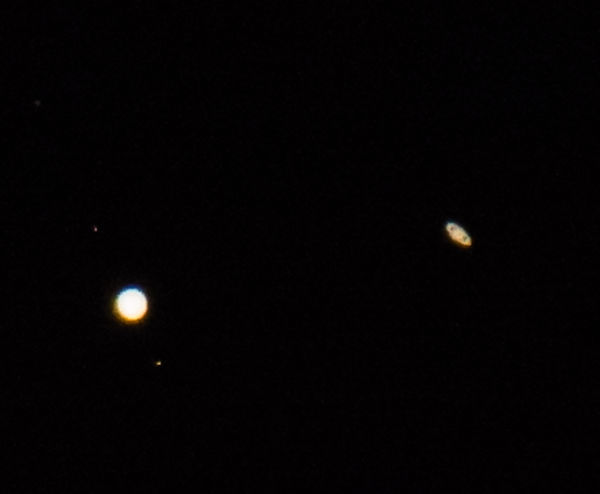Saturn/Jupiter conjuction.
Dec 21, 2020 11:18:19 #
Would be the best exposure-time, ISO, WB, etc for tonight to capture the conjunction?
Dec 21, 2020 11:26:47 #
Because of trees and houses and lay of the land, we are unable to view the conjunction. So must rely on experts here for pictures of the event.
Dec 21, 2020 12:50:48 #
Dec 21, 2020 12:55:21 #
John_F wrote:
Because of trees and houses and lay of the land, we are unable to view the conjunction. So must rely on experts here for pictures of the event.
I have the same problem.
Suppose to be live here: https://www.youtube.com/watch?v=4uiABtFyGPY.
The next will be in November of 2040: https://en.wikipedia.org/wiki/Great_conjunction
(There were lots of occurrences by the way.)
I wonder what life will be like in 7541 for that one.
If we're still here.

Dec 21, 2020 13:07:13 #
Orphoto
Loc: Oregon
Things will depend on your approach to it all. If you photograph the SW sky 30 mins after sunset and are including foreground objects, expose for the sky as you ordinarily would. Do not expect to see much if any detail in Jupiter or Saturn.
Last Thursday I tried to obtain detail like the rings of Saturn and Jupiter's moons. Shooting 45 mins after local sunset using a 500mm f4 lens on a star tracker I exposed for 1 sec at f8, iso 64. White balance at 5200 K. Unless you have significantly more sophisticated equipment do not expect stellar results. You can just barely make out the rings, the moons are tiny points of light.
Good luck!
Last Thursday I tried to obtain detail like the rings of Saturn and Jupiter's moons. Shooting 45 mins after local sunset using a 500mm f4 lens on a star tracker I exposed for 1 sec at f8, iso 64. White balance at 5200 K. Unless you have significantly more sophisticated equipment do not expect stellar results. You can just barely make out the rings, the moons are tiny points of light.
Good luck!
Dec 21, 2020 14:11:38 #
Dec 21, 2020 17:43:41 #
Thanks for your answers but complete cloud cover now and in near future around me. Hope for photos from outside the area soon. Good luck.
Dec 22, 2020 05:54:08 #
DRM
Loc: NC
Longshadow wrote:
I have the same problem.
Suppose to be live here: https://www.youtube.com/watch?v=4uiABtFyGPY.
The next will be in November of 2040: https://en.wikipedia.org/wiki/Great_conjunction
(There were lots of occurrences by the way.)
I wonder what life will be like in 7541 for that one.
If we're still here.
Suppose to be live here: https://www.youtube.com/watch?v=4uiABtFyGPY.
The next will be in November of 2040: https://en.wikipedia.org/wiki/Great_conjunction
(There were lots of occurrences by the way.)
I wonder what life will be like in 7541 for that one.
If we're still here.

Cue Zager and Evans!
Dec 22, 2020 08:35:10 #
been trying for a few days right at first dark , the best was at 1 sec , [anymore , like 2 sec , the circles look like egg shape ] f8 , because that is the max for the older nikkor 800mm with a D300 , 800 iso .the problem you have , is that difference of brightness between the subjects .the small moons are faint , jupiter is BRIGHT , saturn much less .so , if you expose to see the 4 small moons well the stars of the show imo , jupiter will be way too exposed , saturn not so much .so without a real telescope dont expect too much .never figured out to post a pic on that site .
Dec 22, 2020 10:49:03 #
DRM wrote:
Cue Zager and Evans!
Ha ha! - one of my favorites. I remember in 1968 listening to FM and I was able to hear that song on seven different stations, tuning to another station after the song ended on another.
Dec 22, 2020 10:58:25 #
srscary
Loc: Cary, NC
Shellback wrote:
See this post by RE - https://www.uglyhedgehog.com/t-678651-1.html
👍👍👍
I really liked that pic. The fast shutter speed used - 1/60 sec. - was a surprise!
Dec 22, 2020 11:59:47 #
I found the conjunction of Jupiter and Saturn to be difficult to shoot. A 500mm lens could not get any detail of ether planet. Atmospheric diffraction was interfering with good focus. The problem was the conjunction followed the sunset to the horizon in a relatively short time frame. The planets were the brightest close to the horizon but the diffraction made good focus nearly impossible. I did get at decent landscape image with conjuncture high in the sky (upper left in picture). Settings ISO 80, F-22 and 10 sec shutter with 20mm F-1.8 lens.
Dec 22, 2020 14:25:36 #
Dec 22, 2020 19:03:20 #
cwhi1444 wrote:
Would be the best exposure-time, ISO, WB, etc for tonight to capture the conjunction?
Shoot RAW and fix in post. I used my D810 with Tamron 150-600 mm G2 set at 600 mm. F/6.3, 1/10 second, ISO 3200. Swap ISO and shutter speed if you like to follow the rule of 500, which I don't. Use a tripod. Turn OFF whatever vibration reduction your lens has. Retract mirror. Close shutter on viewfinder. Use LIVE VIEW to focus your lens (zoom in of course). Where I am located, the four largest moons of Jupiter are very evident. The rings of Saturn were positioned to make Saturn look elongated.
Good luck and have fun!
Dec 24, 2020 12:26:02 #
My neighborhood has quite a number of trees and I didn't know if the conjunction would be really visible. As a result I was caught completely flatfooted and unprepared to photograph it when I saw that it was low enough to the horizon to be below most of the canope. Since I would be shooting from the middle of the street and didn't know how much time I had to set up I grabbed the camera and a monopod. Camera Nikon 7100, lens Nikon 200-500 at 500mm, f 5.6, 1/100 sec., ISO 2500. What might seem an under exposure allowed the rings of Saturn to appear.
If you want to reply, then register here. Registration is free and your account is created instantly, so you can post right away.










